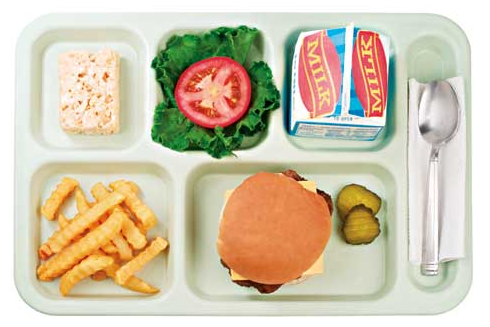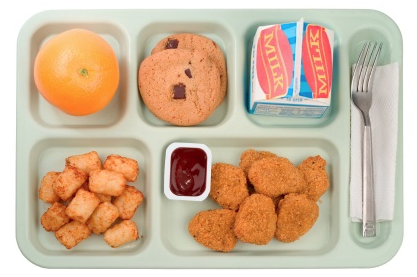 The St. Paul Public School nutrition services staff continue to earn kudos for getting kids to clean their plates. Here’s a story I reported a few years ago about how top chefs have helped them revamp their recipes.
The St. Paul Public School nutrition services staff continue to earn kudos for getting kids to clean their plates. Here’s a story I reported a few years ago about how top chefs have helped them revamp their recipes.
The boys and girls at Galtier Magnet Elementary School don’t know it yet, but they’re about to become the guinea pigs in an experiment that could have ripple effects throughout St. Paul’s public schools–and possibly beyond.
As they slide their trays through the school’s cafeteria line one bright spring day, each receives a bowl of beef barley soup and two pieces of bread, one round and one square. A team of women in clinical white smocks hover at the edge of the room with clipboards, poised to record what happens next. “It’s a big day here,” says Jean Ronnei, director of nutrition services for the St. Paul public schools. The round bread was made by the district’s regular supplier, while the square slice was baked in district ovens from a new recipe that uses heart-healthy whole grain flour but looks as white, fluffy, and familiar as Wonder Bread. “We’re very interested in finding out which kind of focaccia the kids like best,” Ronnei explains.
If focaccia was a foreign concept in the school cafeteria where you cut your teeth, chances are you also survived your formative years without partaking of a substance known as Flaming Hot Cheetos. Before the item was banned from the Galtier lunchroom, this bright red nutrition-free menace was a major source of calories for kids—and a major source of concern for principal John Garcia. More than 80 percent of the students at this magnet school two blocks off University Avenue in the heart of St. Paul qualify for free or reduced-price lunches. More than 70 percent also take part in the school’s subsidized breakfast program, running in from the morning bus and eating so ravenously that Garcia says, “It’s clear a lot kids haven’t eaten a real meal since lunch the day before. They come hungry.”
As he’s watched his students eat—wolfing down fatty, sugary treats, and turning up their noses at fresh fruit and vegetables—something else became clear too: “For many of these kids, everything they’re learning about food and nutrition, they’re learning at school.” With a third of the nation’s children overweight—the obesity rates are even higher rates among low-income and minority students such as those who attend Galtier—the school decided it was time to improve its nutritional lesson plan.
That’s why the women in the white coats—“quality control specialist” is their title—move through the cafeteria, urging some students to try another spoonful of soup (never mentioning the fantastic fiber content of barley) and encouraging others to dunk their focaccia in the soup, like it’s a donut. (Donuts, yet another high-fat, low-nutrient menu item, has also been mostly removed from the Galtier lunchroom—to the chagrin of many faculty members.) Though parents have generally supported Galtier’s recent nutritional push, some have also sent their kids to school with maple syrup on French toast day, apparently believing that the fruit toppings served in its place may simply be too great a sacrifice to expect from sixth-graders.
The notion that kids will reject healthy food is commonly held, often by parents as we’re trying to rationalize another trip to a McDonalds drive-thru. But Ronnei, who was recently named food service director of the year by the School Nutrition Association, believes that kids could develop a taste for what’s good for them if we regularly put good stuff in front of them. “They like green beans—I’ve seen it myself,” she says. As if to demonstrate her point, two girls sitting at the next table sniff suspiciously at the focaccia before taking tentative bites from each piece. After a couple of mouthfuls, the wrinkles in their noses smooth out.
“I like the square one,” says the girl with pigtails. “So do I,” says her friend.
“See there,” Ronnei says. “Two votes for the healthy stuff.”
Though the federal government will spend more than $1 billion this year on nutritional education—including posters promoting healthy snacks and videos starring dancing fruit—a review of fifty-seven such programs found they had almost no effect on what kids ate.
Unfortunately, these results, as they say in the fine print, may not be typical. Though the federal government will spend more than $1 billion this year on nutritional education—including posters promoting healthy snacks and videos starring dancing fruit—an Associated Press review of fifty-seven such programs last summer found they had almost no effect on what kids ate. In fact, in one federal pilot program, students who were given fruit and veggies became less willing to eat them as the year wore on. Among the hurdles on the path to healthier eating are the twenty-one TV commercials the average elementary school student will see every day for candy, snacks, sweetened cereal, and fast food ,and the fact that a lot of us parents aren’t great role models when it comes to eating right. The average American eats only three servings of fruit and vegetables a day, while the latest dietary guidelines recommend we get two to four times that amount. This is why schools, overburdened as they are, may be our best hope in fighting the country’s escalating battle of the bulge.
“It’s not a question of if schools will have an influence, but whether that influence will stick when youth are surrounded by environments, both inside and outside the school, that are incompatible with making good choices,” says Ruth Bowman, who recently evaluated several nutrition education curricula as part of her doctoral dissertation at the University of Minnesota. Bowman points out that Americans will spend $118 billion annually on obesity-related conditions and illnesses that are largely preventable. “We can’t afford to ignore or abandon the issue.”
Still, that’s a lot to expect from school nutrition staffs, who have to craft menus with meager budgets (the average elementary school meal costs approximately $2.50 and must contain a federally mandated minimum of 668 calories), in the face of official indifference (remember when the Reagan administration classified ketchup as a vegetable?), and a student population prone to pitching healthy food in the garbage. But recently school lunch ladies have received unexpected support from famous foodies who recognize the role they play in shaping kids’ tastes. Three years ago, Chez Panisse’s renowned chef Alice Waters persuaded the Berkeley, California, school district to offer academic credit for lunch, making good eating part of the district’s core curriculum. Two years ago, Britain’s “Naked Chef,” Jamie Oliver, gave that nation’s school menus a healthy make-over. And here at home, Seth Bixby-Daugherty, named by Food and Wine as one of the country’s best new chefs in 2005, gave up his gig at Minneapolis’s Cosmos restaurant last winter to, among other things, help figure out how low-income single moms working with the Wilder Foundation could manage to make seven healthy family meals from the average $70 they receive in food stamps.
“It wasn’t easy,” admits Bixby-Daugherty. “Eating poorly, with high fat and processed foods, is definitely cheaper. It’s why obesity has become a problem of poverty.” He compares the obesity crisis to illiteracy, with life consequences just as dire. “That’s why, when I turned forty, I figured I’m half done—what am I going to do the other forty years to really make a difference?” he says. The answer, he and his wife, Karen, decided, was to create a kind of nonprofit consulting group, Real Food Initiatives, to help schools and other organizations change the way this country’s kids eat.
When Bixby-Daugherty quit his high profile job at Cosmos, a local radio station asked him to “go up against” Jean Ronnei from the St. Paul schools. “I guess they expected us to be combative and for me to be really critical of what the schools are doing,” he says. Instead, the two turned out to be kindred spirits, with the chef praising Ronnei and others like her for “the miracles” they’re able to accomplish for pennies a day. Ronnei rewarded him with a homework assignment—to remake the district’s 600-pound recipe for meat lasagna.
“So far, I’ve taken out sixty-five pounds of sugar, and I cut the seventy pounds of salt in half,” reports Bixby-Daughtery, whose new and improved recipe will undergo a test run at St. Paul’s Como High his fall. Though Bixby-Daugherty made his own menu at Cosmos, his experience feeding his own kids, Emma and Cole, has taught him that the crowd at Como High may be harder to please than his paying customers. “It not hard to make things healthier, but you have to make them appealing, too,” he says.
“That’s always the question you have to consider. Will they eat it?”
But, as many school nutritionists will tell you, the answer to that question doesn’t always match the effort put in. Hopkins’s public schools earned nationwide attention when they hired Bertrand Weber, a Swiss-born hotel and restaurant manager, formerly of Minneapolis’s Whitney Hotel, to remake the district’s meal plan. Weber and his staff waged an impressive campaign, removing trans fats and high-fructose corn syrup from the schools’ offerings and creating almost 75 percent of the menu from scratch. They replaced standard cafeteria chicken patties with chicken mole, flabby pastas with heartier whole grains such as quinoa, kasha, and couscous. The changes cost money—about thirty-five cents more a plate at Hopkins High. Sadly, the changes also cost the district student participation in its lunch program.
“I’d say 90 percent of the parents were in favor of what we were doing,” says Michele Wignall, who worked with Weber and took over as the district’s manager of student dining when he departed last year. But, she says, parents at one school decided the revised offerings “weren’t kid-friendly enough,” and participation dropped by 10 percent. The same effect has been noted in Great Britain, where Jamie Oliver’s remade menu resulted in a 30 percent drop in participation at some schools. A British TV series that followed the menu makeover frequently showed parents slipping bags of potato chips through school gates. “It’s really important to educate before you do a change like that,” Wignall says. “Even if people are on board, you have to keep drowning them with information about why this matters.”
St. Paul officials say they’ve learned a few lessons from the Hopkins experience, and are trying to involve the district’s 44,000 students in the menu-making process. A “coolest vegetable” contest yielded high marks for jicama, which is now served is salad bars throughout the district. A recipe for szechuan green beans was rewritten when student feedback revealed that kids like their beans spicier than the original offering. (More like Flaming Hot Cheetos perhaps.) And a veggie meatloaf that “seemed good on paper,” according to Ronnei, “was a total disaster.”
So, all things considered, is the St. Paul initiative working? The average number of fruit and vegetable servings at lunch in the district has risen from 1.98 in 2001-02, to 2.47 in 2005-06. “We’re going up and holding steady,” Ronnei says, even though the district’s kids can no longer take a second serving of French fries, which used to over-represent the amount of veggies served per meal.
More encouraging to Ronnei and her staff are the signs that students will eat what’s good for them, if given a choice. The final tally of the great focaccia experiment was eighty-four votes in favor of the whole grain recipe versus fifty-five for the other. Thanks to the thumbs-up from the discriminating lunch crowd at Galtier, whole-grain focaccia will be served in cafeterias across St. Paul this fall.
originally published in Mpls/St.Paul


